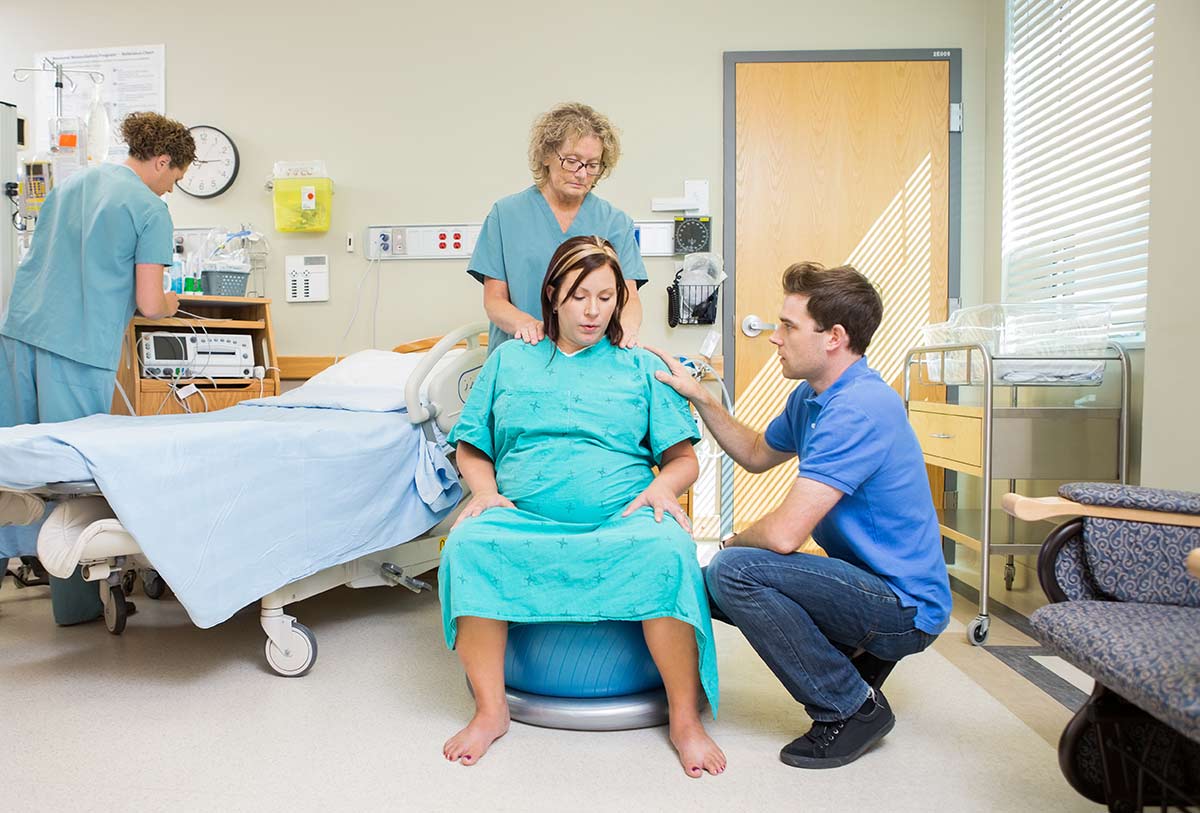Giving Birth: Labor & Delivery Tips for First-Time Moms
Giving birth can be both exciting and terrifying for first-time moms. Just as the rest of your pregnancy has differed from others’, your birth experience will be unique to you and your baby. As you think about the big day when you’ll finally meet your little one, you probably have questions about what to expect!
Here are some of the most common questions I’ve been asked about giving birth for the first time.
Getting Ready for Baby
How important are birthing classes?
Prenatal classes or birthing classes can help you understand what to expect during your labor and delivery. You’ll learn about creating a birth plan, common things that happen in a hospital, and how to manage pain. At Madison Women’s Health, we refer our patients to Unity Point Meriter for prenatal classes. You can begin taking prenatal classes at the start of your second trimester. We recommend completing them before your 37th week of pregnancy.
Prenatal classes can be online or in person. Check with the hospital to see what they currently offer. Prenatal classes typically include a birth center tour. There are classes for singletons and multiples. They are helpful in understanding various things that can happen in labor and delivery that are not common things you see on TV (like ways to monitor your baby’s heart rate and the use of forceps or a vacuum if needed to safely deliver your baby).
Tip: Prenatal classes will help you think of questions you may want to ask your OB during your prenatal check-ups. Keep a list! Classes are a good supplement to your 10-15 minute prenatal visits.
Who can be with me at the birth?
Before the COVID-19 pandemic, there were no restrictions on how many people could be with you during the birth. During any Public Health Emergency, guidelines may change. It’s always a good idea to verify how many people can be there with you.
At the time this article was written, Meriter allowed one support person (in addition to a doula) to be with you. This person can be anyone — your partner, a friend, or a relative. Choose someone who will be supportive and encouraging. Currently, your support person must be the same person throughout the birthing experience. In other words, your support person cannot be your spouse for a few hours, then your mother, and then your sister.
Tip: A doula is considered part of the medical team and is therefore allowed to be involved in your care during the pandemic.
What is the difference between a midwife and a doula?
Midwives have been trained in obstetric procedures. They can interpret fetal monitoring, make recommendations on labor management, and recommend a C-section if it is needed.
Doulas have been trained in the emotional, psychological, and physical support of moms throughout pregnancy, delivery. and postpartum. They have not been medically trained, but their attention and focus on the mom has been shown to improve birth outcomes. Women who use a doula are more likely to have a delivery without pain medications and their labors tend to be shorter.
Tip: A doula does not make medical recommendations or replace your midwife or doctor, but rather they offer extra services and individualized prenatal and labor support.
Read more about choosing the right doula.
What will the labor and delivery room or birthing room look like?
Our patients deliver their babies at Meriter Hospital, which has large birthing rooms. You’ll appreciate having more space to walk around in early labor or sit on a birthing ball. You’ll be able to control the temperature and dim the lighting. Your room will have a couch, perfect for your support person to nap on if needed.
Tip: Meriter’s birth rooms also include a comfortable tub. While we don’t offer water births (in accordance with ACOG recommendations), water immersion during labor can help with relaxation and easing labor pain.
What should I pack in my hospital bag?
If you have to drop what you’re doing and immediately go to the hospital, they will have all the essentials. I usually tell patients, however, that it’s a good idea to have a bag ready to go around 36 weeks. There are things you will want to help make your stay more comfortable.
Here are some ideas for your hospital bag:
-
- Toiletries: Shampoo, conditioner, soap, toothbrush and toothpaste, hair brush, deodorant. While we have these things at the hospital, you’ll probably prefer your own.
- Comfy clothes for you.
- Slippers, socks, or flip-flops.
- Robe and/or nightgown. If you plan to breastfeed, choose a nightgown that opens in the front (although the hospital ones are great for this!)
- Clothes to wear home. Comfortable maternity clothes are usually your best bet. Include a nursing bra if you plan on breastfeeding.
- Going home outfit for your baby. Your baby will be swaddled and diapered during the hospital stay, but most parents want a photo-worthy outfit for the big trip home.l
- Snacks for your partner / your support person. The hospital has a cafeteria (open during the day) and vending machines, but your partner may want to consider anything special they want. Sometimes light snacks are okay in early labor, but we recommend against eating in active labor for safety reasons (and you usually won’t feel like it!).
- Phone charger. Family and friends will want frequent updates and you will fill up your camera roll quickly.
It’s Time!
At what point do I need to go to the hospital? How long should I labor at home?
Most women can spend time in early labor at home. We recommend calling if you have painful contractions every 5 minutes for 1-2 hours to keep us in the loop. Call sooner if your doctor has given you more specific instructions due to medical conditions. If you have had a more complicated pregnancy or if you live far from the hospital, you may be asked to come in sooner. If you think your water has broken, we recommend calling to discuss the best time to come in, which is usually early for safety reasons.
Tip: Everyone has a different pain threshold. A good measure of “painful contractions” means you need to stop and breathe through them without focusing on anything else.
How long is labor for first-time moms?
There are three stages of labor and how long each lasts is very unpredictable for first-time moms. The whole event can last hours or days. Your first labor will be the most unpredictable, while second labors are generally faster.
What are the stages of labor?
Stage 1a: Latent Labor
Contractions during early labor will feel mild, like deep menstrual cramps, and will be irregular. Early labor helps soften, shorten, and thin your cervix. It can start a few days or a few hours before birth.
Stage 1b: Active Labor
During active labor, your contractions become more frequent, regular, and painful. You are considered to be in active labor when your cervix has dilated to 6 cm. The rate of cervical change is more consistent and predictable from this point to “complete” dilation (10 cm). Your doctor will check your cervix to let you know when it’s ok to begin pushing. If you push too soon, before your cervix has fully dilated, you are at risk of tearing your cervix and having significant bleeding.
Stage 2: Pushing Stage / Birth
The second stage is the pushing stage. This stage can last a few minutes or many hours (up to 4 or more if the baby is making progress through the birth canal).
You may think, “how will I know when to push?” If you don’t have an epidural during labor, the urge to push is often very strong. If you have an epidural, you may not notice the urge to push in the same way. We will help you know how and when to push with your contractions.
Stage 3: Placenta Delivery
The placenta generally delivers within 30 minutes of giving birth. We sometimes massage your uterus to help with this (although we say massage, this can be uncomfortable). We strongly recommend every woman receive oxytocin as well. These steps are important to decrease the risk of excess bleeding following delivery.
What should my partner do during labor?
Talk about this with your support person ahead of time so expectations are clear. Some women prefer their partner help with coping with labor pain. Others prefer a more hands off approach. Talk together ahead of time to determine what you are comfortable with.
Tip: Your support person can be supportive in many ways. This can be giving you sips of water and ice chips, holding your hand, being responsible for music, rubbing your back, etc. Do what works best for both of you.
Can I eat and drink while I’m in labor?
If you are undergoing an induction or are at the hospital in early labor, sometimes light snacks are reasonable. A lot of women get nauseous and throw up in labor and are at risk for aspiration, a serious complication. We therefore recommend against eating in active labor. If there’s a possibility of needing a C-section, it is safest to have not had food recently. Most women are not hungry anyway! Water, clear juice, and ice chips are satisfying.
Tip: If you have an I/V, you will be properly hydrated. If your lips get dry from your breathing exercises, ask for some chapstick.
Pain Management
What does giving birth feel like?
Labor pain feels different for everyone, but some general principles include:
- Braxton Hicks contractions — These are common, even as early as the second trimester. You’ll feel your uterus gradually tighten and get soft. This is not painful.
- Early labor — Contractions can feel like strong menstrual cramps lasting 30 to 60 seconds (like a charley Horse in your uterus). Some women feel these contractions in their back.
- Active labor — These are cramps that can’t be described by words. You may feel intense pelvic pressure as you “transition” to 10 cm and your baby descends into the birth canal.
- Pushing stage — Along with the muscle pain of contractions, you will feel stretching and pressure in your vagina.
What are my options to treat labor pain?
Non-Pharmacologic Pain Control:
- Changing positions: You may feel better standing up, resting on your hands and knees, or sitting on a birthing ball. Your body will tell you what is working!
- Taking a warm shower or bath: The warm water can relax tense muscles. Water immersion has been shown to lower pain scores.
- Massage: Your support person, nurse, or doula can massage your back and provide counter pressure during contractions
- Breathing techniques: You’ll learn breathing techniques during your prenatal classes. Staying relaxed and calm helps with pain control.
Pharmacologic Pain Control:
- I/V Narcotic: Some women have good pain relief with an IV or subcutaneous injection of a narcotic medication. We don’t recommend this option if we suspect you will deliver within an hour. This is to let the medication clear from you and your baby’s system before delivery. .
- Epidural: You can request an epidural at any time you are in pain in labor. Some women request an epidural almost immediately, while others choose to have it done later. Medication from an epidural does not transfer to the baby. Learn more FAQs about epidurals for labor pain.
Tip: Each woman has different anatomy and experiences pain differently, so please be careful not to put pressure on yourself to make decisions about your labor based on others experiences. Women who give birth with an epidural have no less of a “natural birth” than someone who did not use pain medication. Each birth is equally as beautiful!
Special Circumstances & Preparing for Unexpected
What about giving birth to twins? How is labor different?
If you’re pregnant with twins, we recommend that you deliver in an operating room instead of the birth room, even if delivered vaginally. While it may not feel as cozy as a birth room, an operating room allows for more room to meet these babies safely. Your OBGYN will counsel prenatally on the safest way to meet your twins, as having two babies at one time comes with more risk than one.
In the United States, the primary Cesarean section (C-section) rate is just over 30%. At Madison Women’s Health, the C-section rate for first-time moms is well under 20%.
What is the likelihood I will need a C-Section?
In the United States, the primary Cesarean section (C-section) rate is just over 30%. At Madison Women’s Health, the C-section rate for first-time moms is well under 20%.
In the United States, the most common reason a woman delivers by C-section is that labor does not progress. In most cases, this is due to cephalopelvic disproportion (when a baby does not fit). The second most common reason is because we see signs a baby is in distress in labor. The recommendation for C-section is made when the benefit of meeting a baby by surgery outweighs the risks.
Tip: Our primary goal in caring for you is a healthy mom and a healthy baby and we will explain our recommendations for that each step of the way. We also want you to have a vaginal birth! We only recommend C-sections if we think the benefit is greater than the risk.
What is an episiotomy? Will I need one?
An episiotomy is a rarely performed medical procedure that involves cutting the perineum to help the baby deliver. Historically, an episiotomy was thought to decrease severity of tearing with delivery. We know through research that letting tearing happen naturally is more beneficial to the mom.
Tip: Episiotomies are only performed in emergency situations, with your consent, when it will help the baby deliver more quickly (a rare occurrence).
Will I tear? How is it treated?
Approximately 90% of women have a vaginal/perineal tear with delivery. Tears are graded as 1st through 4th degree, with 1st as the least amount of tearing. We recommend suturing tears to help them heal appropriately. We do this with stitches that dissolve.
Tip: A new technique, called perineal massage, has been proven to decrease the amount of tearing with delivery.
What about the embarrassing things….like pooping and pubic hair?
Most worry or feel embarrassed about these things, but we don’t even notice!
If you like to wax, I don’t recommend this past the 37th week. We don’t recommend shaving before delivery because it increases your risk of infection. Trust us, we are not paying attention to grooming!
Most women will have a bowel movement in labor or with pushing. This is good! it means you are pushing correctly.
Tip: Trust us. We really don’t care or remember!
Recovery
How long does it take to recover from giving birth?
Every woman is different in how she recovers, too. Postpartum is an awesome time, but also stressful! It is often referred to as the 4th trimester. Your sleep schedule changes, your body changes, and your interpersonal relationships change. If you choose to breastfeed, read up on our breastfeeding tips for new moms.
Vaginal Birth:
Many moms are surprised to know there is still a recovery period. You may have cramping, tailbone pain, and pain as a tear heals. Sometimes sitting and walking are tricky! There are no true lifting restrictions after a vaginal delivery, but I recommend avoiding heavy lifting for about two weeks, especially from the ground. This puts a lot of stress on your pelvic floor as it heals. Helpful tips for going home include sitting on soft surfaces, using a spray bottle after you void, using ice pads, taking ibuprofen and Tylenol, and keeping an area of all the things you will need most to care for you and baby in your home.
C-section:
The recovery from a C-section is longer because it is a major surgery. Wait six weeks before lifting anything greater than 10-15 lbs. We will teach you how to care for your incision in the hospital and will send you home with pain medication.
Final Recommendations
What are your recommendations about giving birth at home?
Home births double your risk of complications, with two times the risk of perinatal mortality and three times the risk of neonatal seizures. We, along with the American Academy of Pediatrics and ACOG, believe the hospital is the safest place to give birth. If you decide to give birth at home, you should have a low-risk pregnancy, the help of a certified midwife, and be reasonably close to a hospital.
Tip: Our first priorities are the health and safety of you and your baby. We will give you information and recommendations about safety and labor so you can make informed decisions throughout the process.
Bring a list of questions to your next OB visit!
 Dr. Ashley Durward has been providing healthcare to women in Madison since 2015 and joined Madison Women’s Health in 2019, specializing in high and low risk obstetrics, contraception and preconception counseling, management of abnormal uterine bleeding, pelvic floor disorders, and minimally invasive gynecologic surgery.
Dr. Ashley Durward has been providing healthcare to women in Madison since 2015 and joined Madison Women’s Health in 2019, specializing in high and low risk obstetrics, contraception and preconception counseling, management of abnormal uterine bleeding, pelvic floor disorders, and minimally invasive gynecologic surgery.












